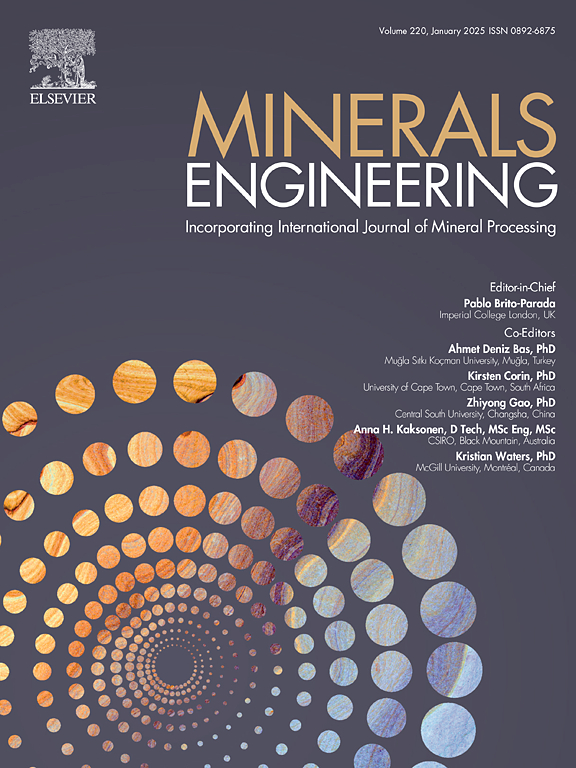三醋酸纤维素/三正辛胺/磷酸三丁酯聚合物包合膜从硫氰酸盐水溶液中回收Co(II)离子
IF 4.9
2区 工程技术
Q1 ENGINEERING, CHEMICAL
引用次数: 0
摘要
介绍了一种聚合物包合膜(PIM),由40%的三乙酸纤维素(CTA)、25%的萃取剂三正辛胺(TOA)和35%的磷酸三丁酯(TBP)作为增塑剂组成,具有理想的物理、机械和萃取性能,可作为钴离子阴离子硫氰酸盐配合物。该PIM直径3.5 cm,在室温下,在轨道摇床上摇2小时(200转/分)后,将50 mL硫氰酸钠溶液调整为0.1 mol L−1,pH为4(醋酸缓冲液),定量提取钴离子(初始浓度为26 mg L−1)。将负载的PIM与50ml调节至pH 8(磷酸盐缓冲液)的乙二胺四乙酸(EDTA) (0.25 mol L−1)溶液接触16 h进行反萃取。所研究的PIM相对于Cd(II)、Ni(II)、Pb(II)、Mn(II)、Cr(III)、Al(III)和Cr(VI)离子表现出对Co(II)的选择性。对萃取数据的分析证实了[(TOAH+)2(Co(SCN)42−)]配合物是萃取物。PIM的最大容量被评估为19.75毫克每克PIM。拟二阶模型和Langmuir模型分别较好地描述了反应的动力学和等温线。本文章由计算机程序翻译,如有差异,请以英文原文为准。
Recovery of the Co(II) ions from thiocyanate aqueous solutions using cellulose triacetate/tri-n-octylamine/tributyl phosphate polymer inclusion membranes
A polymer inclusion membrane (PIM) bearing desired physical, mechanical, and extraction properties towards cobalt(II) ions as their anionic thiocyanate complexes, composed of 40 wt% of cellulose triacetate (CTA), 25 wt% of the extractant tri-n-octylamine (TOA), and 35 wt% of tributyl phosphate (TBP) as the plasticizer, is introduced. A 3.5 cm dimeter segment of this PIM extracts quantitatively cobalt ions (initial concentration 26 mg L−1) from 50 mL solution adjusted to 0.1 mol L−1 sodium thiocyanate and pH 4 (acetate buffer), after 2 h shaking (200 rpm) on an orbital shaker, and at room temperature. The back-extraction process is performed by 16 h by contacting the loaded PIM with 50 mL solution of ethylenediaminetetraacetic acid (EDTA) (0.25 mol L−1) regulated to pH 8 (phosphate buffer). The investigated PIM presents selective attitude towards Co(II) with respect to Cd(II), Ni(II), Pb(II), Mn(II), Cr(III), Al(III), and Cr(VI) ions. Analysis of the extraction data confirms the formation of the [(TOAH+)2(Co(SCN)42−)] complex as the extracted species. The maximum PIM’s capacity is appraised to be 19.75 mg per g of the PIM. Pseudo-second order and Langmuir models describe well respectively the kinetics and the isotherm of the process.
求助全文
通过发布文献求助,成功后即可免费获取论文全文。
去求助
来源期刊

Minerals Engineering
工程技术-工程:化工
CiteScore
8.70
自引率
18.80%
发文量
519
审稿时长
81 days
期刊介绍:
The purpose of the journal is to provide for the rapid publication of topical papers featuring the latest developments in the allied fields of mineral processing and extractive metallurgy. Its wide ranging coverage of research and practical (operating) topics includes physical separation methods, such as comminution, flotation concentration and dewatering, chemical methods such as bio-, hydro-, and electro-metallurgy, analytical techniques, process control, simulation and instrumentation, and mineralogical aspects of processing. Environmental issues, particularly those pertaining to sustainable development, will also be strongly covered.
 求助内容:
求助内容: 应助结果提醒方式:
应助结果提醒方式:


